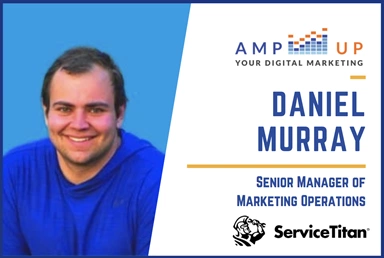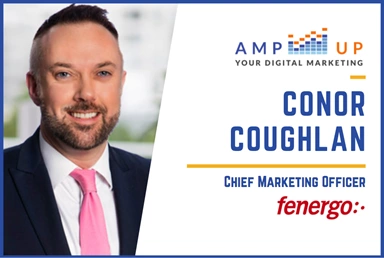Podcast
The ‘AMP Up Your Digital Marketing’ Podcast Presents:
What’s Product-Led Growth? Tips to Help SaaS Marketers Implement It

Product-led growth has gained a ton of traction among marketers everywhere, but it looks very different in the SaaS industry.
In this episode of AMP Up Your Digital Marketing, Glenn Gaudet speaks with Jason McClelland, CMO at Domino Data Lab. They talk about the importance of product-led growth in the SaaS industry and how to execute it successfully.
- Product-led growth is a huge trend in marketing these days, but traditionally it works best for products that are fairly straightforward, like Netflix and Spotify.
- Leveraging product-led growth for a highly technical audience can be tricky, but it can pay off immensely. Jason says it helps him generate interest amongst developers and data scientists, who typically don’t care about flashy marketing initiatives — they just want to try the product out.
- Once a user has opted into a free trial or freemium product, you have to nurture them through the process. It’s like a Ferrari, Jason explains. You can’t just throw someone into the driver’s seat and say, “Go.”
Product-led growth is a hot topic in the marketing industry these days.
It’s a marketing strategy that relies on the product to do the heavy-lifting through free trials and freemium models. Marketing veteran Jason McClelland is calling product-led growth “a huge movement and is the next frontier – the newest frontier.”
Sure, it’s not like this approach just landed on the scene yesterday, but it’s picked up a ton of traction in the last several years. Just take a look around and see how many free trials you’ve been offered today.
But what does product-led growth look like when you work with a highly technical product in the SaaS industry? It’s not always as straightforward as handing out a seven-day free trial.
Jason understands this firsthand. Before joining Domino Data Lab, he spent years working at Adobe and Heroku, which was acquired by Salesforce.
“Our biggest barrier-to-entry was people would come in, they'd sign up for a trial, they’d look at a blank white page and go, ‘OK, now what?’ It's like somebody's giving you a Ferrari, but you don't know how to drive a stick shift,” he explains, referencing Photoshop’s free trials.
Jason joined the AMP Up Your Digital Marketing podcast to explain what product-led growth is, what it looks like in a more technical field, and shares tips on how to turn these initiatives into long-term successes.
What’s Product-Led Growth, Anyway?
Product-led growth (PLG) can be a smart way to draw people into your product — or get them hooked, so to speak. You’re letting the product speak for itself by letting interested users sign up for a free trial or freemium service.
“The product-led growth way of doing things is to try to catch people super early,” Jason said. “This is through freemium models, free trials, and content marketing… It's really trying to help shape the conversation when people are very early in their journey.”
At Domino Data Lab, Jason markets to developers and data scientists. The only issue? “They abhor sales and marketing,” he said. “They will do anything they can to not get on the phone, not to send an email, and not to get on a webinar.”
At the end of the day, they just want to try the service out, and a free trial or freemium product allows them to do just that.
Making Product-Led Growth Marketing Work in the SaaS Industry
Traditionally, a successful product-led growth campaign requires a simple and approachable product or service, Jason explains. Think about Netflix or Spotify. Once you’ve signed up for your free trial, the user experience is pretty self-explanatory — it doesn’t require an in-depth tutorial.
A more technical product or service will need more explanation — more hand-holding — but that doesn’t mean the product-led growth approach won’t work.
Jason shares his expert tips to make product-led growth work for you — even when you’re marketing a super technical product or service.
1. Find Your Community and Share Engaging, Credible Content
Because Jason understands the more traditional marketing techniques won’t necessarily resonate with developers and data scientists, he proves he wants to make their jobs easier by sharing credible, helpful, and relevant content in their communities.
When sharing Domino Data Lab content, he focuses on platforms where his audience hangs out — like Data Science Central, Hacker News, Medium, and even Reddit threads.
“It's not about me selling to you,” he explains. “It's about me trying to help you do your job, and hopefully over time, you start to think, ‘Oh, this is a company that's going to help my company do our job and accomplish what we want to do.’”
This is a long-term strategy, but one he’s dedicated to achieving. In his opinion, Hubspot has achieved this perfectly, and that’s his ultimate benchmark.
“If they see that we're always engaging there, then that's going to drive them to our trial,” he says.
2. Nurture Your Technical Buyer With How-To Guides and Examples
Once a user has opted in to a free trial, you have to nurture them through the journey — making sure they don’t get “stuck” at a certain step or point in the process.
Of course, it’d be nice to give each user a step-by-step in-product experience, but Jason explains that’s a longer-term endeavor, one that can take years to build. Instead, he suggests starting with short-term wins.
First, you can use the content you’re creating to help. For instance, write content tailored to different verticals, uses, and cases. He likes to show new users examples of what Domino Data Lab can do, like “Look what we did with Slack” or “Check out what GitHub created.”
Second, Jason suggests setting up triggers. If a user hits a certain step in the process, it’ll alert you as a marketer to reach out. There are various prompts, but Jason throws out an example: “Hey, it looks like you’re trying to do this. Here’s some extra information, and, by the way, look at how this company did it.”
Remember: It’s like a Ferrari. You can’t just throw someone in the driver’s seat and say, “See you later.”
3. Keep Testing, Keep Improving
With product-led growth, it’s all about testing, optimizing, and improving. For Jason and his team, this is a constant work-in-progress.
His team has been doing a lot of iteration around the trial experience. They’re trying to determine how much to give away and how much to withhold.
“What do we not give away for free? What's enough to get people hooked? And by hooked, I mean, they're actually doing meaningful work,” Jason explains.
At the end of the day, it comes down to a lot of testing (and analyzing data) and talking directly to your customers to strike the perfect balance.
AMP Up Your Digital Marketing brings together the leading marketing practitioners to share how they are succeeding in today’s digital landscape. Each podcast episode focuses on providing you with the knowledge and strategies you need to be a successful marketer. Subscribe via Apple, FIR Podcast Network, or wherever you get your podcasts.
Want to appear on AMP Up Your Digital Marketing? Contact Us and let us know how our listeners can benefit from hearing your message.

Ramin Edmond
Ramin Edmond is the former Content Strategist for GaggleAMP.








